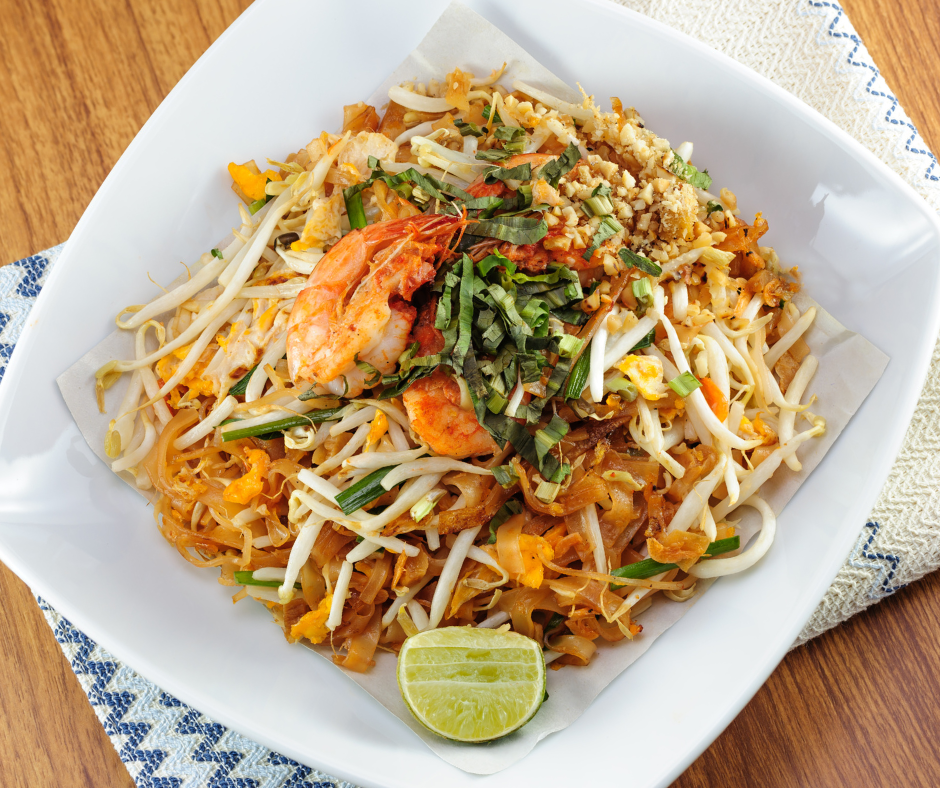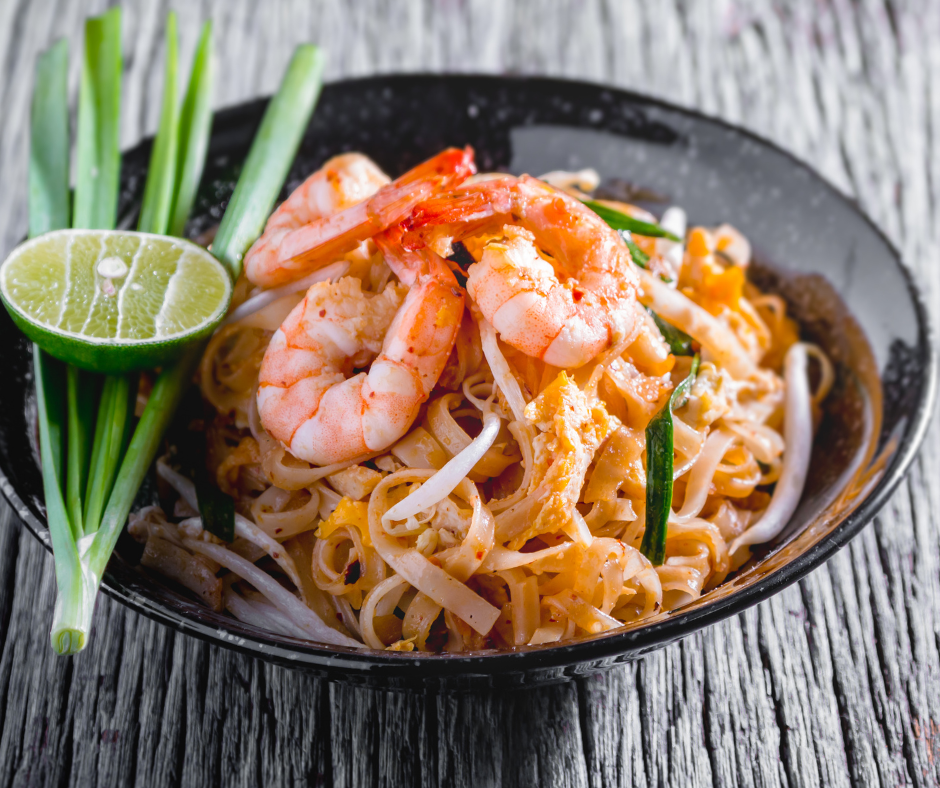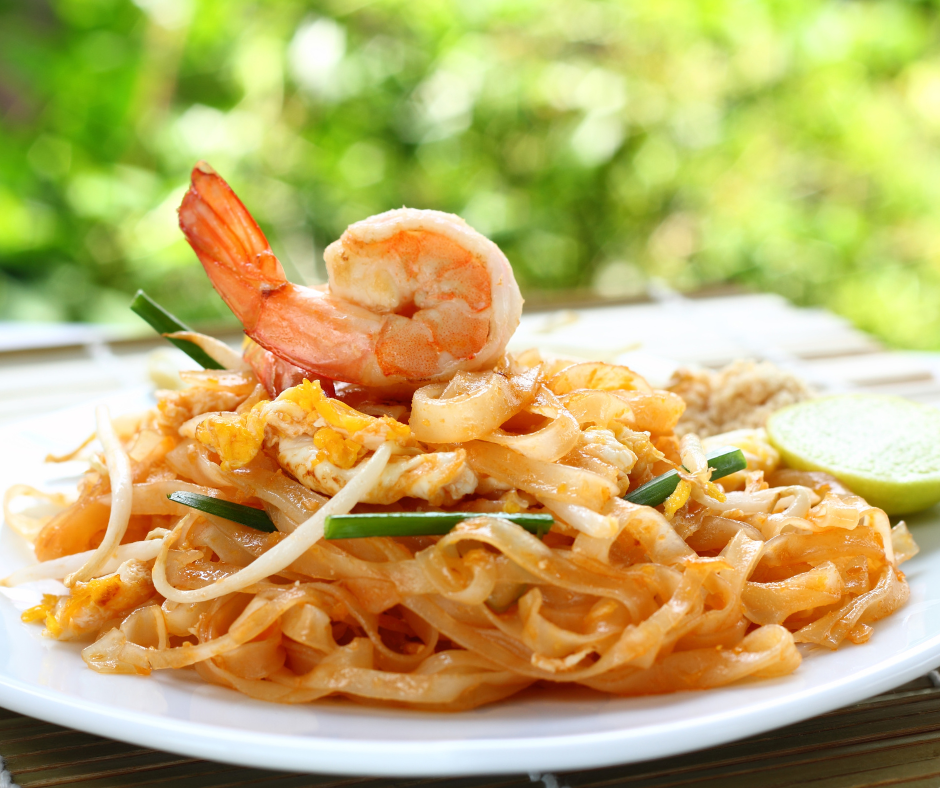Introduction To Pad Thai
Pad Thai is a beloved and popular Thai dish that has gained international recognition for its unique flavors and textures. If you’re a fan of Thai cuisine or you’re looking to try something new and delicious, Pad Thai is a must-try dish. In this article, we will explore the Nutrition Facts Pad Thai for you.
What Is Pad Thai?
Pad Thai is a stir-fried noodle dish consisting of rice noodles, eggs, tofu or shrimp, bean sprouts, peanuts, and a flavorful sauce. The sauce is made from tamarind paste, fish sauce, sugar, and other ingredients, giving it a perfect balance of sweet, salty, and tangy flavors.
One of the reasons why Pad Thai is so popular is its versatility. You can customize the dish by adding vegetables, meat, or seafood. It can be spicy or mild, depending on your preference.
The Cultural Significance Of Pad Thai
Pad Thai holds a special place in Thai culture. It is a national dish often served in street markets, restaurants, and homes throughout Thailand. It is a dish that brings people together, symbolizing the importance of shared meals and communal eating.
Pad Thai is also a reflection of the cultural influences that have shaped Thailand’s cuisine. It incorporates flavors and ingredients from different regions of the country and pays homage to the blending of Chinese and Thai culinary traditions.
Despite its global popularity, Pad Thai has retained its authentic flavors and remains a staple in Thai cuisine. It showcases the vibrant flavors that make Thai food so beloved worldwide.
Regarding the Nutrition Facts Pad Thai, it’s important to note that the exact composition can vary depending on the specific recipe and ingredients used. However, in general, Pad Thai can be a healthy and balanced meal option.
The dish typically contains a lot of protein from sources like tofu or shrimp, essential vitamins and minerals from vegetables, and healthy fats from peanuts. Rice noodles provide carbohydrates for energy.
It is worth noting that the sauce used in Pad Thai may contain added sugars and sodium, so it’s important to consume it in moderation if you are watching your sugar or salt intake.
Overall, Pad Thai is a delicious and satisfying dish that blends flavors and textures. Whether you enjoy it as a simple weeknight meal or as a special treat at a Thai restaurant, Pad Thai will tantalize your taste buds and introduce you to the wonderful world of Thai cuisine.
Nutrition Facts Pad Thai
Calories And Macronutrients In Pad Thai
Pad Thai is a popular Thai dish known for its unique combination of flavors and textures. If you’re watching your calorie intake or trying to maintain a balanced diet, it’s important to know the Nutrition Facts Pad Thai.
A typical serving of Pad Thai contains around 290-400 calories. The exact number may vary depending on the restaurant or recipe, as some versions of Pad Thai may be higher in calories due to added oils or ingredients.
Regarding macronutrients, a serving of Pad Thai usually provides around 13-17 grams of protein, 40-60 grams of carbohydrates, and 8-15 grams of fat. Remember that these values can vary based on the specific recipe or ingredients.
Vitamins And Minerals In Pad Thai
Pad Thai also provides a range of vitamins and minerals that contribute to your overall health and well-being. Here are some key nutrients found in Pad Thai:
- Vitamin C: Pad Thai often includes ingredients like lime or lemon juice, which adds a refreshing citrus flavor and boosts vitamin C. Vitamin C helps support a healthy immune system.
- Vitamin A: Pad Thai typically contains ingredients like carrots and bean sprouts, which are good sources of vitamin A. This vitamin is important for maintaining healthy eyesight and supporting immune function.
- Iron: Some versions of Pad Thai may include ingredients like tofu or shrimp, which are good sources of iron. Iron is essential for transporting oxygen throughout the body and maintaining energy levels.
- Potassium: Pad Thai often incorporates vegetables like bell peppers or broccoli, which are rich in potassium. Potassium helps regulate blood pressure and supports proper muscle function.
It’s worth noting that the Nutrition Facts Pad Thai can vary depending on the specific recipe and cooking method. To keep things lighter, you can also opt for healthier alternatives like zucchini or carrot noodles instead of traditional rice noodles.
Overall, Pad Thai can be enjoyed as part of a balanced diet, providing a mix of macronutrients, vitamins, and minerals. As with any dish, portion size and ingredient choices are crucial in determining its nutritional value.
Health Benefits Of Pad Thai
Regarding delicious Thai cuisine, Pad Thai is a crowd favorite. But aside from its amazing taste, have you ever wondered about the nutritional value of this popular dish? Let’s take a closer look at the nutrition facts of Pad Thai and the health benefits it can offer.
High Protein Content In Pad Thai
One of the most notable health benefits of Pad Thai is its high protein content. It typically includes ingredients like tofu, shrimp, or chicken, all of which are excellent protein sources. Protein is essential for building and repairing tissues, promoting muscle growth and strength, and supporting overall body function. Including protein-rich Pad Thai in your diet can help you meet your daily protein requirements and maintain a healthy and balanced diet.
Fiber And Its Benefits In Pad Thai
Another advantage of Pad Thai is its fiber content. This dish often contains ingredients like vegetables and peanuts that are rich in fiber. Fiber is essential for maintaining a healthy digestive system, reducing the risk of heart disease, and promoting weight management. When consumed regularly, Pad Thai can contribute to your daily fiber intake, supporting optimal digestion and overall health.
In addition to these key benefits, Pad Thai contains other essential nutrients such as vitamins, minerals, and healthy fats. However, it’s important to note that the nutritional content can vary depending on the specific recipe and ingredients used.
It’s worth mentioning that while Pad Thai can be a nutritious option, it’s also important to consume it in moderation and consider any dietary restrictions or preferences you may have.
So the next time you enjoy a plate of Pad Thai, you can feel good knowing that you’re not only savoring a delicious meal but also reaping some health benefits along the way.
Potential Downsides Of Pad Thai
High Carbohydrate Content In Pad Thai
While Pad Thai is undoubtedly a delicious Thai favorite, it’s important to be mindful of its high carbohydrate content. One serving of Pad Thai typically contains around 300-400 calories, mostly from carbohydrates. This may not be ideal for individuals following a low-carb or keto diet. Additionally, the high carb content can cause a rapid rise in blood sugar levels, which can be a concern for those with diabetes or insulin resistance.
Saturated Fat And Cholesterol In Pad Thai
Pad Thai can also be high in saturated fat and cholesterol. This is mainly due to the use of oil for cooking the noodles and adding flavor to the dish. The oil used in traditional Pad Thai recipes is usually palm oil, which is high in saturated fat. Consuming excessive amounts of saturated fat can contribute to an increased risk of heart disease and high cholesterol levels.
While the overall fat content in Pad Thai may not be too high, it’s important to be mindful of portion sizes and consider the overall balance of your diet. If you enjoy Pad Thai, it may be worth considering healthier cooking alternatives, such as using less oil, or alternative cooking methods like stir-frying with less oil or vegetable broth.
It’s also worth noting that Pad Thai often contains peanuts or peanut sauce, which can concern individuals with peanut allergies. If you have a peanut allergy, be cautious when ordering or preparing Pad Thai, and consider alternative dishes that don’t contain peanuts.
In conclusion, while Pad Thai is undoubtedly a delicious and popular Thai dish, it’s important to know its potential downsides. The high carbohydrate content, saturated fat, and cholesterol levels can concern individuals with certain dietary restrictions or health conditions. However, with mindful portion control and healthier cooking alternatives, you can still enjoy Pad Thai as part of a balanced diet.
Pad Thai And Specific Health Conditions
When it comes to Thai cuisine, one dish that stands out is Pad Thai. Known for its flavorful combination of stir-fried noodles, vegetables, and protein, Pad Thai has become a favorite for many. But have you ever wondered about its nutritional value, especially if you have specific health conditions? Let’s take a closer look.
Pad Thai And Diabetes
For individuals with diabetes, managing carbohydrate intake is crucial. Traditional Pad Thai typically contains rice noodles, which are high in carbs. However, you can make some modifications to create a healthier version. Opting for whole-grain noodles or using spiralized vegetables instead of noodles can help reduce the carb content. Adding plenty of vegetables and lean protein like shrimp or tofu can also help balance the meal and provide additional nutrients.
Pad Thai And Heart Health
When it comes to heart health, moderation is key. While Pad Thai can be high in sodium and saturated fats due to fish sauce and added oils, there are ways to make it healthier. Choosing low-sodium options or reducing the amount of fish sauce used can help lower sodium intake. Additionally, using healthier cooking oils like olive oil or avocado oil and adding more vegetables can improve the overall nutritional profile of the dish.
It’s also important to note that portion control plays a significant role in maintaining heart health. Keeping the serving size in check and balancing Pad Thai with other nutritious foods can help prevent excessive calorie and fat intake.
In summary, Pad Thai can be enjoyed even with specific health conditions like diabetes or heart disease. By making mindful modifications and being conscious of portion sizes, you can still savor the flavors of this Thai favorite while supporting your health goals.
Remember, consulting with a healthcare professional or registered dietitian can provide personalized guidance based on your health condition and dietary needs.
FAQ about Nutrition Facts Pad Thai: The Nutritional Breakdown of a Thai Favorite
Q: What are the nutritional values of Pad Thai?
A: The nutritional values of Pad Thai can vary depending on the specific ingredients used and the serving size. On average, a serving of Pad Thai contains approximately 328 calories, 12 grams of protein, 18 grams of fat, 32 grams of carbohydrates, 3 grams of fiber, 9 grams of sugar, and 128 milligrams of calcium.
Q: Are there any benefits to eating Pad Thai?
A: Pad Thai can provide a good amount of protein, which is essential for building and repairing tissues in the body. It also contains carbohydrates for energy and fiber for digestive health. Additionally, Pad Thai often includes vegetables, such as bean sprouts, which can contribute to your daily intake of vitamins and minerals.
Q: What are the downsides of eating Pad Thai?
A: One of the potential downsides of Pad Thai is its high-fat content. While some fats are necessary for a healthy diet, consuming too much saturated fat, which is often found in Pad Thai, can increase your risk of heart disease. Additionally, Pad Thai can be high in sodium, which can negatively impact blood pressure levels if consumed in excess.
Q: Can Pad Thai be a healthy option?
A: Yes, Pad Thai can be a healthy option if prepared with certain modifications. To reduce the calorie content, consider skipping the stir-fried rice noodles and adding more vegetables instead. Opting for a moderate amount of lean protein, such as chicken or shrimp, can also make the meal healthier. It is also recommended to ask for MSG to be left out of your dish if you are watching your sodium intake.
Q: How do the nutritional values of prepackaged Pad Thai compare?
A: The nutritional values of prepackaged Pad Thai can vary, but one example shows that a serving of prepackaged Pad Thai with white chicken meat (311g) provides approximately 429 calories, 82 grams of carbohydrates, 4.04 grams of fiber, 26 grams of sugar, 20 grams of protein, 2.46 grams of total fat, and 659 milligrams of sodium.
Q: Can you provide specific nutritional values for different types of Pad Thai?
A: Yes, here are the approximate nutritional values for 1 cup of different types of Pad Thai:
- Meatless Pad Thai: 328 calories, 12 grams of protein, 18 grams of fat, 32 grams of carbohydrates, 3 grams of fiber, 9 grams of sugar, 128 milligrams of calcium, 2 milligrams of iron, 58 milligrams of magnesium, 172 milligrams of phosphorus, 242 milligrams of potassium, and 692 milligrams of sodium.
- Chicken Pad Thai: 306 calories, 18 grams of protein, 14 grams of fat, 29 grams of carbohydrates, 8 grams of sugar, 40 milligrams of calcium, 1 milligram of iron, 50 milligrams of magnesium, 180 milligrams of phosphorus, 322 milligrams of potassium, and 684 milligrams of sodium.
- Seafood Pad Thai: 290 calories, 14 grams of protein, 30 grams of carbohydrates, 66 milligrams of calcium, 54 milligrams of magnesium, 192 milligrams of phosphorus, 252 milligrams of potassium, and 700 milligrams of sodium.
Q: Can Pad Thai be part of a healthy diet?
A: Yes, Pad Thai can be part of a healthy diet when consumed in moderation and made with nutrient-rich ingredients. It is important to consider portion sizes, choose lean protein options, incorporate plenty of vegetables, and be mindful of added fats and sodium.
Conclusion
In conclusion, Pad Thai is a delicious and popular dish that balances flavors and textures. While it can be a tasty indulgence, it is important to know about the Nutrition Facts Pad Thai. Pad Thai can be high in calories, sodium, and fat, but it also provides essential nutrients like protein and fiber. By making some small adjustments and using healthier ingredients, you can enjoy a lighter and more nutritious version of this Thai favorite.
Summary Of The Nutrition Facts Pad Thai
Pad Thai typically consists of rice noodles, protein (such as shrimp, chicken, or tofu), eggs, bean sprouts, tamarind paste, palm sugar, fish sauce, and garnishes like peanuts and lime wedges. Here is a breakdown of its nutritional content:
- Calories: A typical serving of Pad Thai contains around 500-600 calories.
- Protein: It provides a moderate amount of protein, weighing 15-20 grams per serving.
- Fat: Pad Thai can be high in fat, mainly from the oil used for cooking and adding peanuts. A serving can contain around 15-20 grams of fat.
- Carbohydrates: It is rich in carbohydrates due to the rice noodles and sugar content, with approximately 60-70 grams per serving.
- Fiber: Pad Thai contains some fiber from the vegetables, but the amount can vary depending on the recipe or ingredients used.
Tips For Making A Healthier Version Of Pad Thai
If you want to enjoy Pad Thai while keeping it healthier, here are some tips you can follow:
- Use whole wheat noodles or zucchini noodles instead of traditional rice noodles to increase the fiber content.
- Opt for lean protein sources like grilled chicken or tofu instead of fried proteins.
- Reduce the amount of oil used for cooking by stir-frying with a small amount of cooking spray or using a non-stick pan.
- Add more vegetables like bell peppers, carrots, or broccoli to increase the nutrient density.
- Swap palm sugar with a natural sweetener like honey or maple syrup, or reduce the amount of sugar altogether.
- Limit or omit the garnishes like peanuts and fried shallots to reduce the fat and calorie content.
By making these adjustments, you can still enjoy the flavors of Pad Thai while making it a healthier choice. Remember to practice portion control and moderation to maintain a well-balanced diet.
Pad Thai can be a delicious and satisfying meal, but it is essential to be mindful of its nutritional content. By understanding the breakdown and making healthier choices, you can indulge in this Thai favorite without compromising your health and wellness.



